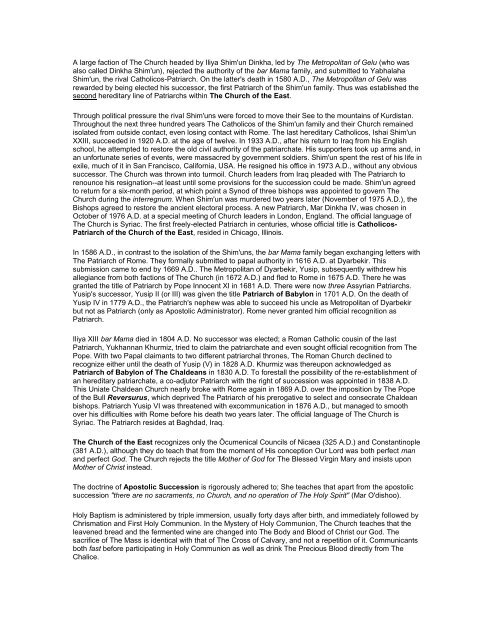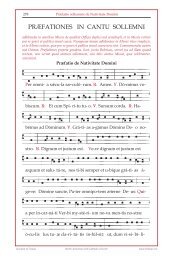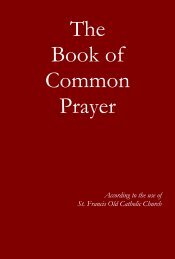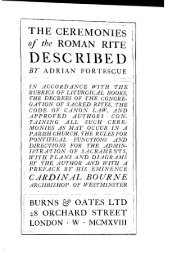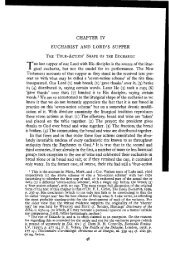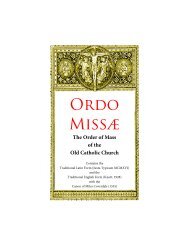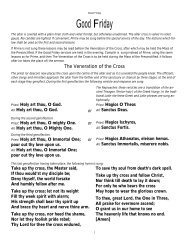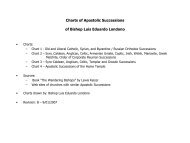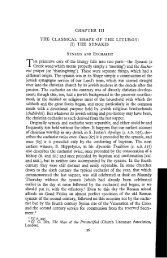Official Record of Apostolic Succession of
Official Record of Apostolic Succession of
Official Record of Apostolic Succession of
Create successful ePaper yourself
Turn your PDF publications into a flip-book with our unique Google optimized e-Paper software.
A large faction <strong>of</strong> The Church headed by Iliya Shim'un Dinkha, led by The Metropolitan <strong>of</strong> Gelu (who was<br />
also called Dinkha Shim'un), rejected the authority <strong>of</strong> the bar Mama family, and submitted to Yabhalaha<br />
Shim'un, the rival Catholicos-Patriarch. On the latter's death in 1580 A.D., The Metropolitan <strong>of</strong> Gelu was<br />
rewarded by being elected his successor, the first Patriarch <strong>of</strong> the Shim'un family. Thus was established the<br />
second hereditary line <strong>of</strong> Patriarchs within The Church <strong>of</strong> the East.<br />
Through political pressure the rival Shim'uns were forced to move their See to the mountains <strong>of</strong> Kurdistan.<br />
Throughout the next three hundred years The Catholicos <strong>of</strong> the Shim'un family and their Church remained<br />
isolated from outside contact, even losing contact with Rome. The last hereditary Catholicos, Ishai Shim'un<br />
XXIII, succeeded in 1920 A.D. at the age <strong>of</strong> twelve. In 1933 A.D., after his return to Iraq from his English<br />
school, he attempted to restore the old civil authority <strong>of</strong> the patriarchate. His supporters took up arms and, in<br />
an unfortunate series <strong>of</strong> events, were massacred by government soldiers. Shim'un spent the rest <strong>of</strong> his life in<br />
exile, much <strong>of</strong> it in San Francisco, California, USA. He resigned his <strong>of</strong>fice in 1973 A.D., without any obvious<br />
successor. The Church was thrown into turmoil. Church leaders from Iraq pleaded with The Patriarch to<br />
renounce his resignation--at least until some provisions for the succession could be made. Shim'un agreed<br />
to return for a six-month period, at which point a Synod <strong>of</strong> three bishops was appointed to govern The<br />
Church during the interregnum. When Shim'un was murdered two years later (November <strong>of</strong> 1975 A.D.), the<br />
Bishops agreed to restore the ancient electoral process. A new Patriarch, Mar Dinkha IV, was chosen in<br />
October <strong>of</strong> 1976 A.D. at a special meeting <strong>of</strong> Church leaders in London, England. The <strong>of</strong>ficial language <strong>of</strong><br />
The Church is Syriac. The first freely-elected Patriarch in centuries, whose <strong>of</strong>ficial title is Catholicos-<br />
Patriarch <strong>of</strong> the Church <strong>of</strong> the East, resided in Chicago, Illinois.<br />
In 1586 A.D., in contrast to the isolation <strong>of</strong> the Shim'uns, the bar Mama family began exchanging letters with<br />
The Patriarch <strong>of</strong> Rome. They formally submitted to papal authority in 1616 A.D. at Dyarbekir. This<br />
submission came to end by 1669 A.D.. The Metropolitan <strong>of</strong> Dyarbekir, Yusip, subsequently withdrew his<br />
allegiance from both factions <strong>of</strong> The Church (in 1672 A.D.) and fled to Rome in 1675 A.D. There he was<br />
granted the title <strong>of</strong> Patriarch by Pope Innocent XI in 1681 A.D. There were now three Assyrian Patriarchs.<br />
Yusip's successor, Yusip II (or III) was given the title Patriarch <strong>of</strong> Babylon in 1701 A.D. On the death <strong>of</strong><br />
Yusip IV in 1779 A.D., the Patriarch's nephew was able to succeed his uncle as Metropolitan <strong>of</strong> Dyarbekir<br />
but not as Patriarch (only as <strong>Apostolic</strong> Administrator). Rome never granted him <strong>of</strong>ficial recognition as<br />
Patriarch.<br />
Iliya XIII bar Mama died in 1804 A.D. No successor was elected; a Roman Catholic cousin <strong>of</strong> the last<br />
Patriarch, Yukhannan Khurmiz, tried to claim the patriarchate and even sought <strong>of</strong>ficial recognition from The<br />
Pope. With two Papal claimants to two different patriarchal thrones, The Roman Church declined to<br />
recognize either until the death <strong>of</strong> Yusip (V) in 1828 A.D. Khurmiz was thereupon acknowledged as<br />
Patriarch <strong>of</strong> Babylon <strong>of</strong> The Chaldeans in 1830 A.D. To forestall the possibility <strong>of</strong> the re-establishment <strong>of</strong><br />
an hereditary patriarchate, a co-adjutor Patriarch with the right <strong>of</strong> succession was appointed in 1838 A.D.<br />
This Uniate Chaldean Church nearly broke with Rome again in 1869 A.D. over the imposition by The Pope<br />
<strong>of</strong> the Bull Reversurus, which deprived The Patriarch <strong>of</strong> his prerogative to select and consecrate Chaldean<br />
bishops. Patriarch Yusip VI was threatened with excommunication in 1876 A.D., but managed to smooth<br />
over his difficulties with Rome before his death two years later. The <strong>of</strong>ficial language <strong>of</strong> The Church is<br />
Syriac. The Patriarch resides at Baghdad, Iraq.<br />
The Church <strong>of</strong> the East recognizes only the Öcumenical Councils <strong>of</strong> Nicaea (325 A.D.) and Constantinople<br />
(381 A.D.), although they do teach that from the moment <strong>of</strong> His conception Our Lord was both perfect man<br />
and perfect God. The Church rejects the title Mother <strong>of</strong> God for The Blessed Virgin Mary and insists upon<br />
Mother <strong>of</strong> Christ instead.<br />
The doctrine <strong>of</strong> <strong>Apostolic</strong> <strong>Succession</strong> is rigorously adhered to; She teaches that apart from the apostolic<br />
succession "there are no sacraments, no Church, and no operation <strong>of</strong> The Holy Spirit" (Mar O'dishoo).<br />
Holy Baptism is administered by triple immersion, usually forty days after birth, and immediately followed by<br />
Chrismation and First Holy Communion. In the Mystery <strong>of</strong> Holy Communion, The Church teaches that the<br />
leavened bread and the fermented wine are changed into The Body and Blood <strong>of</strong> Christ our God. The<br />
sacrifice <strong>of</strong> The Mass is identical with that <strong>of</strong> The Cross <strong>of</strong> Calvary, and not a repetition <strong>of</strong> it. Communicants<br />
both fast before participating in Holy Communion as well as drink The Precious Blood directly from The<br />
Chalice.


